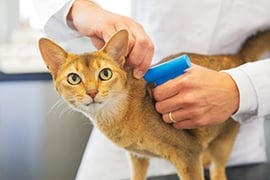Is your pet microchipped?
Each year over 3 million dogs and cats are euthanized at US animal shelters according to data from the US Humane Society. It is easy to think that your pet won’t be one of them, especially if they are wearing a collar with a name tag and contact information. But, what if that collar comes off or they aren’t wearing it that day for some reason? How will your furry family member get back to you?
Thankfully, there are now high tech ways to identify lost pets and all it takes is a visit to your veterinarian to make sure your pet doesn’t become a statistic. A microchip implant, which is about the size of a grain of rice, can be easily implanted under your pet’s skin and is encoded with a unique number that is linked to all of your contact information in a secure database.
How is the microchip put in my pet?
Implanting the device is actually a very simple process and can easily be done during a routine visit to your veterinarian. It doesn’t even require anesthesia! Using a hypodermic needle, similar to the kind that is used to give vaccines, your veterinarian “injects” the microchip under your pet’s skin (usually between the shoulder blades). Your pet may feel a moment of discomfort but a little moment of ‘ouch’ is far better than being separated from you forever.
Is it expensive to have my pet microchipped?
Although the prices will vary from vet to vet, the cost of a microchip is typically between $25 and $65 plus the cost of registration (you have to register your information with the microchip company in order to have your pet in the database). Definitely worth the peace of mind.
If your pet gets lost, an animal shelter, rescue group, or vets office, can use a scanner to find the chip by waving it over your pet. The scanner reads the radio frequency waves from the chip and finds the unique ID number assigned to your pet. This can then be used to find your contact information in the microchip database.
A note of caution:
It is worth knowing that not all shelters or veterinary offices will have a scanner that can look for a microchip in a lost pet. In some cases, even if they do, not all scanners are able to “read” all microchips because some companies use encrypted radio frequencies that only work with their specific scanners. Fortunately, many microchip companies are switching to universal chips and scanners so this is becoming less of a problem. None the less, chips are not foolproof so collars, tags, and vigilance continue to be an important part of keeping your pet safe.
Please make an appointment with your Best Friends veterinarian today to discuss microchipping for your pet.





